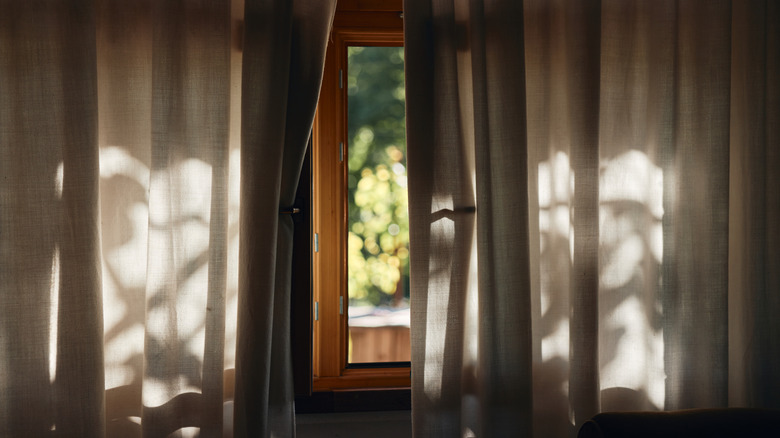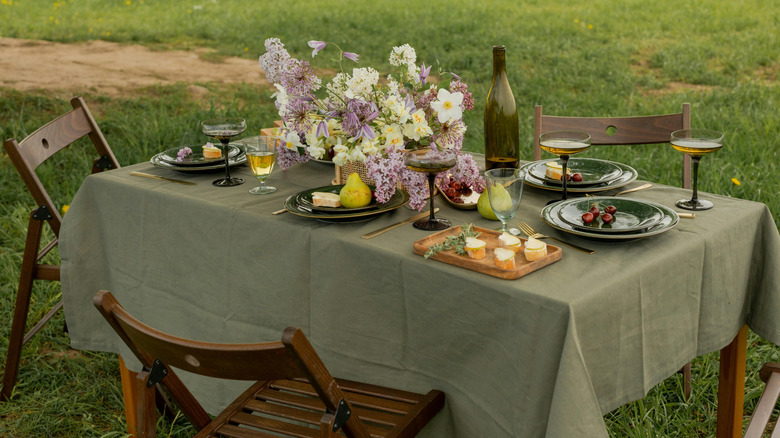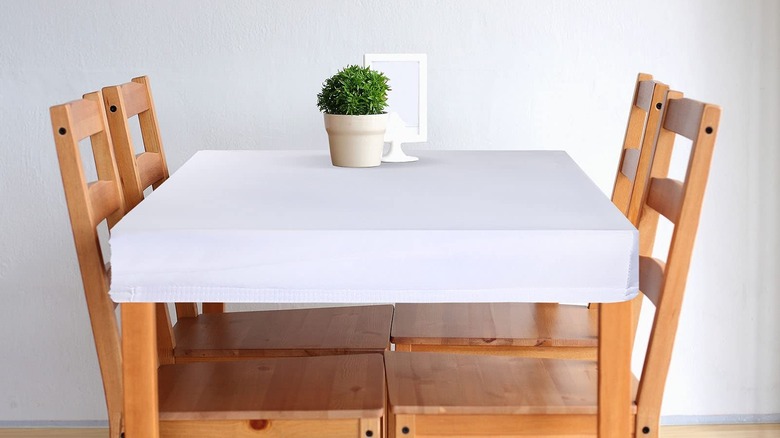Repurpose An Old Pair Of Curtains For A Beautiful Dining Room Mainstay
We may receive a commission on purchases made from links.
Curtains can be expensive, so you might be reluctant to part with them even if they no longer have a place in your home. Because they are essentially large strips of fabric, they're incredibly useful outside their intended purpose, allowing you to reuse curtains in creative ways. By turning your old curtains into a fitted tablecloth, you can give them new life as a central part of your dining room, refining your décor in the process.
The tablecloth has been around since 100 CE, and it has remained a mainstay of the dining experience because of its utility and aesthetic advantages. A tablecloth protects the table's surface as well as making spills and crumbs easier to clean — rather than cleaning the table, you just pull off the tablecloth and toss it in the wash. Because curtains are often made of heavier, more durable materials, they make for great tablecloths, and reusing the curtain fabric instead of tossing it is a more sustainable solution. While you can sew your tablecloths together to make a traditional tablecloth that drapes over the surface, you have the perfect opportunity to make a fitted tablecloth. A fitted structure helps keep your tablecloth in place, providing even more protection for your table while remaining aesthetically pleasing. If your table is a strange shape or has decorative elements that stick out, making your own fitted tablecloth gives you the flexibility to accommodate those oddities.
What types of curtains make good tablecloths
Curtains come in a variety of different materials and styles, and some are better for tablecloths than others. Cotton or polyester fabrics are the best for tablecloths, as they're durable and easy to clean. Of these two materials, cotton is the most versatile, and it withstands washing better than materials like linen. Though the fabric is more sensitive to repeated washing, linen tablecloths are synonymous with luxury restaurants, so repurposing linen curtains into tablecloths is a great choice for anyone looking to add a splash of elegance to their dining room.
Sheer or lace curtains can make for pretty decorative tablecloths, but they are not durable enough for daily use. Sheer materials like chiffon, voile, and organza are also difficult to sew, so they're not as beginner friendly as cotton or polyester. If you're up to the task, curtains made of these trickier decorative fabrics can become tablecloths for smaller side or entryway tables, which won't experience the rough handling that a dining table will.
How to turn a pair of curtains into a tablecloth
Constructing your own tablecloth from old curtains is an affordable way to update your dining room, and it's easy to do. All you need is your curtains, measuring tape, fabric scissors, a pencil (or other marking implement), and a sewing machine. The tablecloth can be handsewn if you don't have a sewing machine, but a machine makes the process faster. Begin by measuring your tabletop, adding ¾ inch of overhang as well as a ½ inch seam allowance. Then flip your curtain upside down, laying the exterior side to the surface of your table, and mark the table's shape and size on the back of the curtain. Cut along the ½ inch seam allowance line and set aside the fabric that will become the top of the tablecloth.
Using your measuring tape, measure from the surface of your table to where you'd like the table skirt to end. Table skirts can be long, reaching the height of a chair, but they can also be only a few inches. If you have a rectangular table, you can cut out four skirt pieces that match the length of each side, but if your table is ovular, one long strip looks best. Cut out your skirt pieces, also leaving a ½ inch seam allowance. Sew your skirt pieces to the top piece, pressing the fabric right-sides together and following the ½ inch seam allowance line. Overlock the edges to prevent fraying. Finally, fold the hem in twice, sewing the folds down to finish off the piece. You can add elastic beneath the hem to better secure the tablecloth, but this won't look as refined as a simple hemmed edge.


